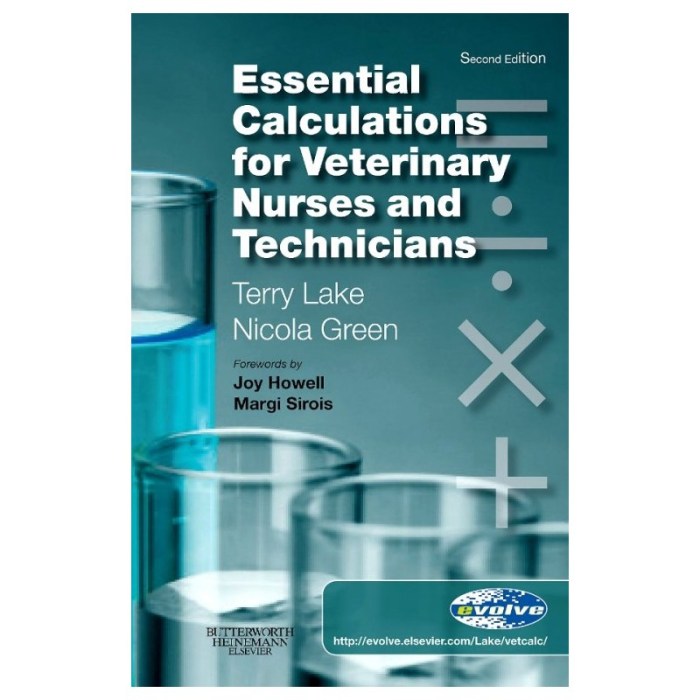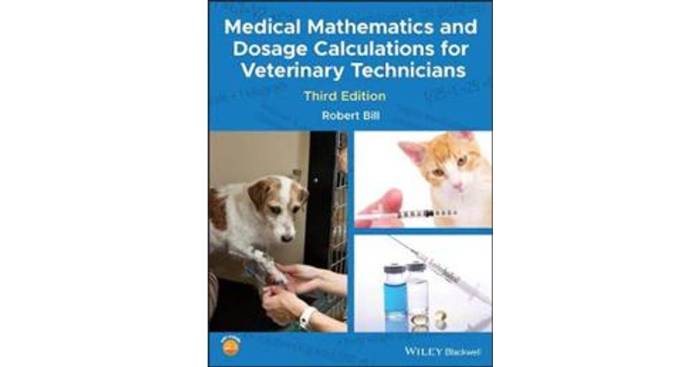Essential calculations for veterinary nurses and technicians – Essential calculations form the cornerstone of veterinary nursing and technician practice, enabling accurate drug administration, fluid therapy, nutritional support, anesthesia, and various other procedures. This comprehensive guide delves into the principles and applications of these calculations, empowering veterinary professionals to deliver optimal care.
Mastering essential calculations requires a solid understanding of the underlying principles, meticulous attention to detail, and the ability to apply knowledge in real-world scenarios. This guide provides a structured approach, breaking down complex concepts into manageable steps, ensuring proficiency and confidence in performing these calculations.
Essential Calculations for Veterinary Nurses and Technicians

Accurate drug calculations are essential for veterinary nurses and technicians to ensure the safe and effective administration of medications to animals. Incorrect drug calculations can lead to serious consequences, including underdosing, overdosing, and even death.
Common drug calculations performed in veterinary settings include calculating drug dosages, dilution rates, and infusion rates. Veterinary nurses and technicians must have a thorough understanding of the principles of drug calculations and be able to apply them accurately in a variety of situations.
Drug Calculations
- Calculating drug dosages based on animal weight, species, and condition
- Calculating dilution rates for injectable medications
- Calculating infusion rates for intravenous fluids and medications
Fluid Therapy Calculations, Essential calculations for veterinary nurses and technicians
Fluid therapy is an essential component of veterinary care, and veterinary nurses and technicians must be able to calculate fluid requirements accurately. The principles of fluid therapy include understanding the body’s fluid compartments, electrolyte balance, and the effects of fluid administration on the animal’s cardiovascular system.
Veterinary nurses and technicians must be able to calculate fluid requirements for different animal species and conditions, taking into account factors such as age, weight, and underlying health conditions.
Nutritional Calculations
Veterinary nurses and technicians must have a basic understanding of the nutritional requirements of different animal species and life stages. They must be able to calculate calorie and nutrient requirements for individual animals, taking into account factors such as age, weight, and activity level.
Veterinary nurses and technicians must also be able to monitor nutritional status and make adjustments to the animal’s diet as needed.
Anesthesia Calculations
Anesthesia is an essential part of many veterinary procedures, and veterinary nurses and technicians must be able to calculate anesthetic doses accurately. The principles of anesthesia include understanding the different types of anesthetic agents, their effects on the animal’s body, and the monitoring of the animal’s vital signs during anesthesia.
Veterinary nurses and technicians must be able to calculate anesthetic doses for different animal species and procedures, taking into account factors such as age, weight, and underlying health conditions.
Other Essential Calculations
In addition to the essential calculations discussed above, veterinary nurses and technicians may also need to perform a variety of other calculations, including:
- Blood transfusion calculations
- Urine specific gravity calculations
- Body condition scoring
Veterinary nurses and technicians must have a comprehensive understanding of the principles behind these calculations and be able to apply them accurately in a variety of situations.
FAQ Overview: Essential Calculations For Veterinary Nurses And Technicians
What are the most common drug calculations performed in veterinary settings?
Common drug calculations include determining drug dosages based on body weight, calculating dilution rates for injectable medications, and converting between different drug units.
How do I calculate fluid requirements for different animal species?
Fluid requirements are typically calculated based on body weight, species, and clinical condition. Various formulas and guidelines are available to assist in these calculations.
What factors should be considered when calculating nutritional requirements for individual animals?
Nutritional requirements vary depending on species, age, weight, activity level, and health status. Factors such as energy needs, protein requirements, and vitamin and mineral supplementation must be taken into account.

